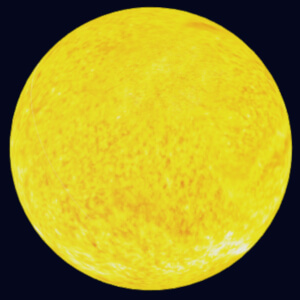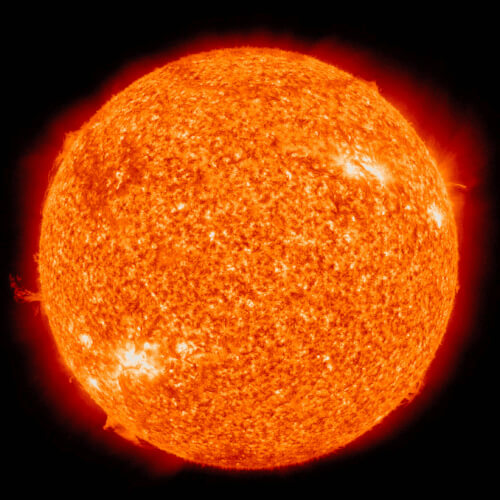



The Sun is the yellow dwarf star at the center of the solar system. It is a nearly perfect sphere, of super heated plasma with a surface temperature of approximately 5,505 °C. Astronomers have calculated the sun's age to be approximately 4.60 billion years, which is about 9.1 billion years younger than the Milky Way Galaxy, where it resides.
All life on Earth owes its existence, directly or indirectly, to the energy emitted by the Sun in the form of heat and other forms of radiation. We describe the time of day as well as time of year based on the Earth's current position, relative to the Sun.
| The Sun | Earth | |
|---|---|---|
| Chemical Composition by Mass | Hydrogen (70.6%), Helium (27.4%), Other Elements (2%) | Iron (32.1%), Oxygen (30.1%), Silicon (15.1%), Magnesium (13.9%), Other Elements (8.8%) |
| Mass | 1.989 × 1030 kg | 5.972 × 1024 kg |
| Volume | 1.409 × 1018 km3 | 1.083 × 1012 km3 |
The sun has the mind-boggling mass of approximately 1,989,000,000,000,000,000,000,000,000,000 kg (one nonillion, nine hundred eighty nine octillion kilograms). This is extremely close to the mass of the solar system as a whole. In contrast, the largest planet, Jupiter, with its mass of about 1,899,000,000,000,000,000,000,000,000 kg (one octillion eight hundred ninety-nine septillion kilograms), makes up a teeny-tiny 0.09% of the solar system!
Because the Earth is millions of kilometers away from the Sun, the photons, particles of light, emitted by the Sun take about 500 s to reach Earth through the vacuum of space. That means that the sun we're looking at is actually how the Sun looked several minutes ago!
The Sun has already burned through about half of its total supply of hydrogen (H). When it runs out, it will become a red giant and expand to a size so enormous that it will completely engulf all the planets in the solar system. About 1 billion years later, it will then transform into a white dwarf. But not to worry— this entire process should take another 7-8 billion years or so.
The Sun emits extremely hot and high-energy ejections of plasma that can travel through space at up to 1.440 million kph. The Aurora Borealis and Aurora Australis, or northern and southern lights are caused by the interactions of the Sun's solar winds with Earth's atmosphere.
The Sun is so enormous that about 1.3 million planet Earths could fit inside of it, by volume. Even in the case of Jupiter, the largest planet in the solar system, about 1,000 Jupiters could fit inside the Sun.
The extremely strong force of gravity created by the sun is constantly causing its own atoms to squeeze together. When two of the sun's hydrogen atoms are crushed together with enough energy, a nuclear reaction called fusion takes place, fusing the atoms together to form a single helium (He) atom. This reaction releases even more incredible amounts of energy being released—a single solar flare can release the energy equivalent of 100 atomic bombs exploding all at once.